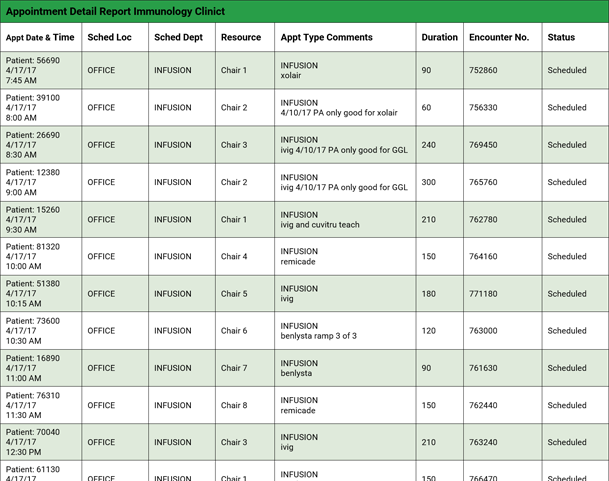Scheduling
- How many people do you need to hire?
Setting your ideal staff-to-patient ratio can be a challenge, but it is simpler to tackle this task if you start by determining how much space and equipment you need, and the specific therapy types you expect to offer most frequently. Once you have identified those factors, build your staffing schedule around them. Here is an example staff and services schedule to consider.


An Efficient Practice: Scheduling and Timing
Kristin Epland, MSN, FNP-C
Midwest Immunology Clinic and Infusion Center
Building Your Practice Schedule?
3 Essential Questions to Ask

How long will each infusion take?

How long should you monitor each patient for, post-infusion?

Do you need a doctor or other advanced practice clinician onsite during the infusion?
- Choosing to offer infusion services on specific days of the week (eg, Mondays and Fridays) can help you concentrate additional staffing needs on those days only. You might also consider designating a specific day (eg, Wednesdays) for infusion patients with complex diagnoses and/or multiple comorbidities, and scheduling additional support staff accordingly.
- Other points to consider.
- Private practice clinicians typically schedule 18 patients per 8-hour clinical day. Of these 18 patients, 2-3 of them may need infusion services. Can you accommodate all 3 infusions on the same day?
- If an infusion patient does not show, can you reallocate the infusion space for another purpose? That is, is the infusion chair located in an exam room?
- Can you add walk-in or wait-listed patients in real time based on the no-show rate?
- If possible, use your existing EHR to schedule infusion appointments as a time- and labor-saving measure.
Practice Pearl: Consider having infusions run during your clinical downtime, such as when you and your staff are charting. That way, you are still available for patient consult and supervision should the need arise, but you are not taking time away from essential charting tasks.
Reminder: If your EHR and/or scheduling system allows it, assign a time signature to infusion resources (ie, an infusion chair) when booking patients. Be sure to build in time to establish the IV line and post-infusion monitoring time. You may also want to build in a cushion of time between patients to reduce unnecessary crowding of the infusion room(s).









